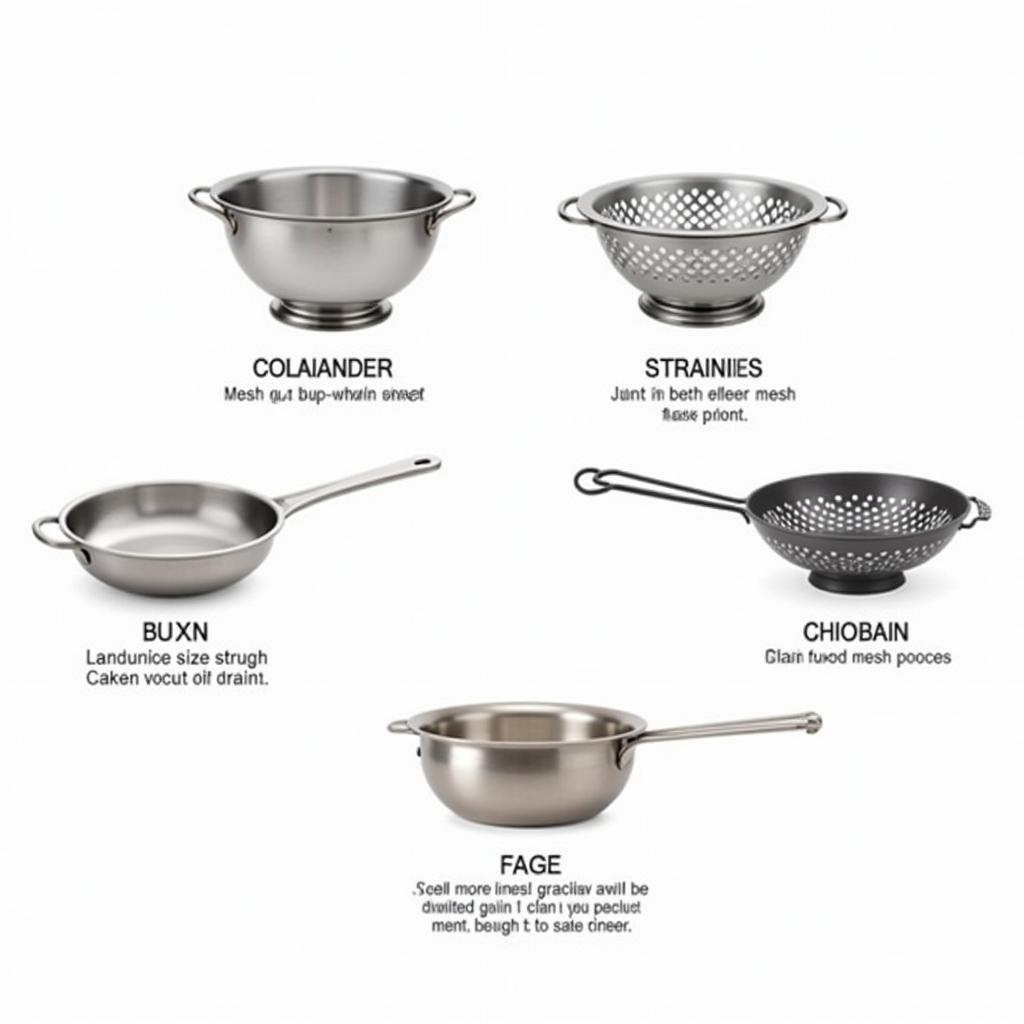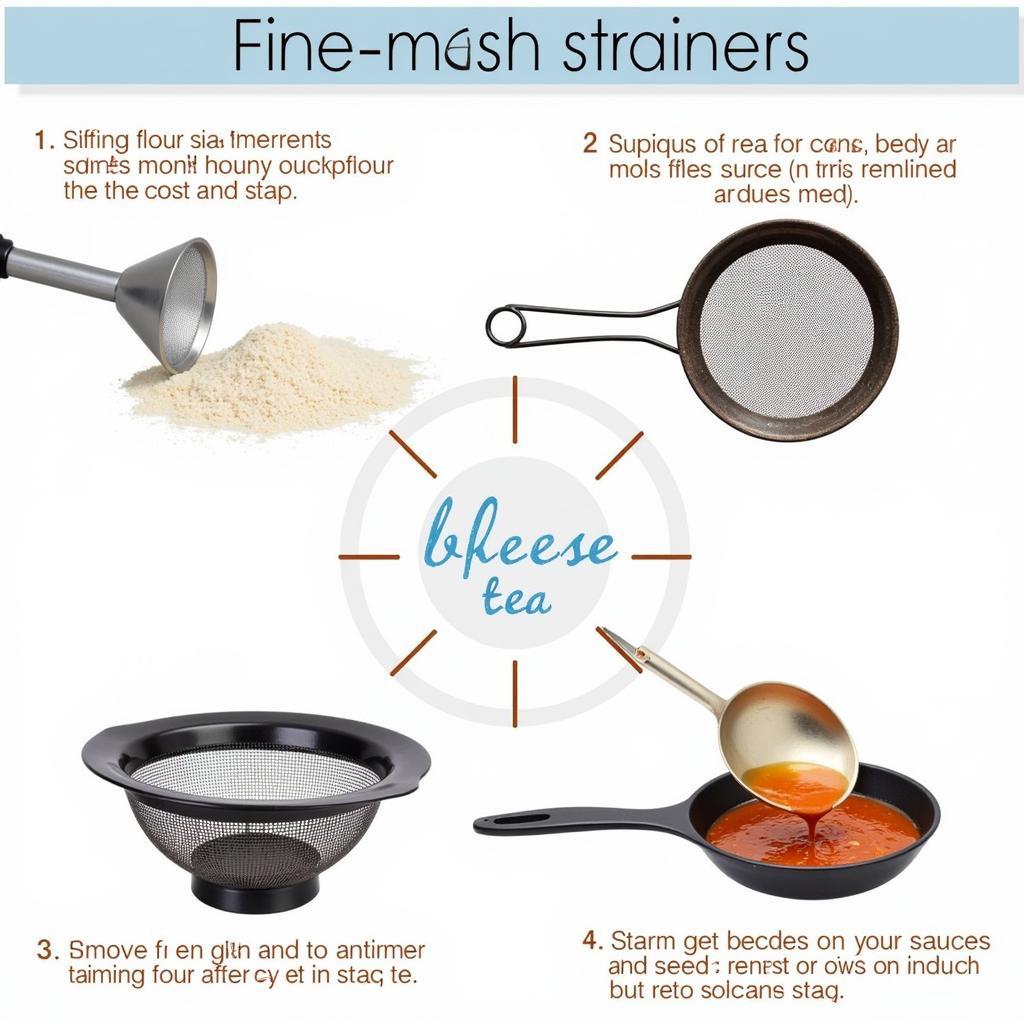Food Drains are essential tools in any kitchen, helping to separate solids from liquids efficiently. Whether you’re straining pasta, rinsing vegetables, or preparing a delicious broth, understanding the different types of food drains and how to use them effectively can significantly enhance your culinary experience. Let’s dive into the world of food drains and discover how they can transform your cooking.  Different Types of Food Drains: A Comparison
Different Types of Food Drains: A Comparison
Exploring the Diverse World of Food Drains
Food drains come in a variety of shapes and sizes, each designed for specific tasks. From the ubiquitous colander to the specialized chinois, each type offers unique advantages. Choosing the right food drain can make all the difference in your cooking process. For instance, a food prep sink often incorporates a built-in drain, streamlining the washing and prepping process.
Colanders: The Kitchen Workhorse
The colander is a kitchen staple, recognizable by its bowl-like shape and perforated sides. Its larger holes make it ideal for draining pasta and rinsing vegetables. Its sturdy construction can handle heavier foods, making it a versatile tool for any home cook. What are the key features of a good colander? Look for sturdy handles, stable bases, and drainage holes that are large enough to allow water to pass through quickly but small enough to prevent food from slipping through.
Strainers: Fine-Mesh Filtration for Delicate Tasks
Strainers, unlike colanders, have a finer mesh, making them perfect for tasks requiring more delicate filtration. They excel at removing seeds from sauces, straining tea leaves, and dusting powdered sugar over desserts. Their fine mesh also makes them suitable for draining smaller grains like quinoa or couscous. Do you know the difference between a fine-mesh strainer and a chinois? A chinois has an even finer mesh, typically conical in shape, and is used for creating incredibly smooth sauces and purees.
 Fine Mesh Strainers for Specific Kitchen Tasks
Fine Mesh Strainers for Specific Kitchen Tasks
Food Drain Maintenance and Care
Proper care and maintenance can extend the life of your food drains. Always wash them thoroughly after each use to remove food particles and prevent clogging. For stubborn stains, try soaking them in warm soapy water. Most colanders and strainers are dishwasher safe, but it’s always best to check the manufacturer’s instructions. Imagine straining a flavorful broth only to find lingering remnants from the previous use. Proper cleaning is essential for maintaining hygiene and preventing cross-contamination of flavors.
Choosing the Right Material for Your Food Drain
Food drains are commonly made from stainless steel, plastic, or silicone. Stainless steel is durable, rust-resistant, and dishwasher safe, making it a popular choice. Plastic is lightweight and affordable, but may be less durable than stainless steel. Silicone is heat-resistant and flexible, making it ideal for draining hot liquids. If you’re planning on planting a best food plot for shaded areas, you might need a completely different type of drain!
Maximizing the Use of Food Drains in Your Kitchen
Food drains are not limited to just draining pasta and vegetables. They can be used in a variety of creative ways to enhance your cooking. Use a colander to steam vegetables by placing it over a pot of boiling water. A fine-mesh strainer can be used to create homemade ricotta cheese or yogurt. A food plot seeder is another kind of “drain”, designed for spreading seeds efficiently. Thinking outside the box can unlock the full potential of these versatile kitchen tools.
Conclusion: The Essential Role of the Food Drain
Food drains, from the simple colander to the specialized chinois, play a vital role in any kitchen. Understanding their various types and applications can significantly improve your culinary skills and efficiency. By investing in quality food drains and practicing proper care and maintenance, you can ensure these essential tools will serve you well for years to come. A well-chosen food drain can truly elevate your cooking experience. Don’t forget to explore the fascinating world of the elephant food plant in az for a completely different perspective on food and plants.
FAQ
- What is the best material for a food drain?
- Can I use a food drain to steam vegetables?
- How do I clean a food drain properly?
- What is the difference between a colander and a strainer?
- What is a chinois and what is it used for?
- Are all food drains dishwasher safe?
- Can I use a food drain to rinse grains like quinoa?
For further assistance, please contact us at Phone Number: 02437655121, Email: minacones@gmail.com or visit our address: 3PGH+8R9, ĐT70A, thôn Trung, Bắc Từ Liêm, Hà Nội, Việt Nam. We have a 24/7 customer support team.